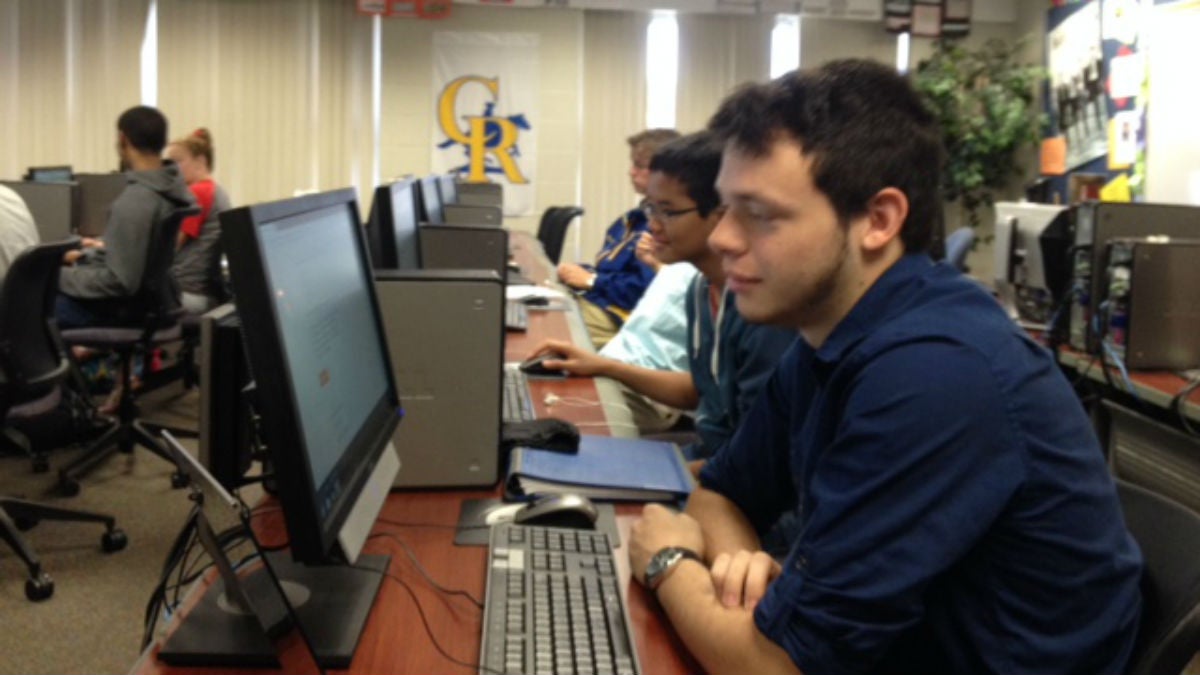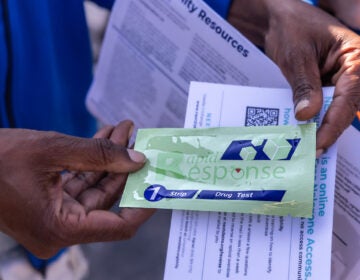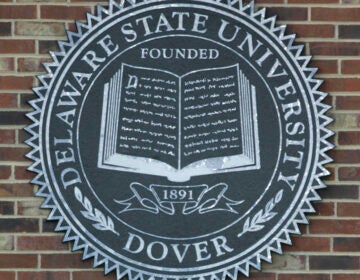The MOOC heads back to high school in Delaware

Caesar Rodney senior Ryann Perez takes his AP Computer Science course online. (Avi Wolfman-Arent, NewsWorks)
First consider the word: MOOC.
It hardly sounds futuristic, more like the kind of grunting sound you’d hear in sports stadiums or frat houses.
Liz Boaman still isn’t sure what it means.
“I don’t know what the initials stand for, but I know how it works,” said the accounting and business teacher at Caesar Rodney High School, just south of Dover.
MOOC is short-hand for Massive Open Online Course, and Boaman is on the front lines of one of the nation’s first MOOCs for high school students. Since last fall she has been an on-site “coach” for an AP Computer Science MOOC created by the education services firm Amplify.
Her experience in that role has been frustrating, illuminating, and inspiring–a fittingly vague referendum on one of the education world’s most buzzed-about new classroom models.
Roots in higher ed
The term MOOC emerged out of higher education seven years ago, where it has come to describe a set of open-access, unlimited-enrollment classes that some believe can transform the college experience.
Unlimited enrollment means that, unlike other online courses, a single MOOC can have hundreds of thousands of students from all over the world. The potential benefits are notable: expanded reach in a world of vast educational inequities, reduced cost in a time of runaway college debt. Just as notable are the potential drawbacks: mechanization in an era where teachers often feel under siege, diluted quality for a generation that needs the opposite.
So far, MOOCs have largely been the domain of higher ed, considered too experimental and impersonal for high school students to navigate.
A MOOC with training wheels
Amplify, which is run by a prominent ed reformer and owned by media kingpin Rupert Murdoch, is among those looking to change that. Amplify’s AP Computer Science course–now in its second year–is like a MOOC with training wheels. In addition to the online component, districts and states can pay for teaching materials–including a 600-plus-page manual–that they then distribute to on-site “coaches.”
The coaches–people like Liz Boaman–don’t teach the course. Students instead watch online videos and ask content questions via a web forum. But the coaches do play on oversight role.
“For us, having that coach right there with the student makes a big, big difference,” said Rebecca Dovi, a veteran computer science teacher from Richmond, Virginia and the course’s lead designer. “It just gives that personal touch of someone checking in on you.”
Delaware paid Amplify $17,500 so that any school statewide could offer this blended MOOC model. The early returns show both the promise and peril of this new educational model.
Expanded access
First, the good stuff.
Prior to the MOOC, only four high schools in Delaware offered AP Computer Science. This year, 23 were able to provide the course.
At Caesar Rodney High School, that meant students like senior Ryann Perez were able to take an advanced coding class for the first time. Perez wants to be a computer science major in college, but had no prior background in Java, the computer language taught in AP Computer science.
“I’ve looked at logic and stuff, but I’ve never really delved into Java or anything, so this is completely new,” Perez said.
He wasn’t daunted, however, and quickly became a resource for other Caesar Rodney students taking the class. He’ll now head to Delaware Technical and Community College in the fall with a firm footing in his preferred field.
Experiences like Perez’s are distressingly uncommon. Nationwide, nearly four times as many high schools offer AP English Literature as offer AP Computer Science. That’s a worrisome gap given the booming workforce demand in computer science and related fields.
“The fact is, students are graduating into a world that doesn’t just use computers, but really [is] informed by them,” said Dovi, the MOOC’s creator.
Addressing a shortage
Dovi believes the lack of AP Computer Science courses stems from a teacher shortage. Those who have the technical knowledge needed to teach the course, she said, can make far more money in the for-profit sector.
Then there’s the problem of student concentration. In order to justify offering any course in a bricks-and-mortar setting, a school needs dozens of interested students. In the MOOC, format, however, a school where interest is relatively low can still offer AP Computer Science. In fact, there are schools in Delaware where just one student is enrolled in the course.
That flexibility also applies to the way students take AP Computer Science. At Caesar Rodney, some take the class during an open period while others, such as senior Jessica Howell, have an otherwise full schedule but manage to squeeze in study time during nights and weekends.
“I work at Chick-fil-a, so I’m guaranteed my Sundays,” Howell said with a chuckle.
In order to recruit students for the class, Delaware’s Department of Education advertised the MOOC to over 900 high school students with high PSAT scores. Last fall, 155 enrolled. By the end of the year, only 88 remained.
Reduced quality?
That number hints at the not-so-good part of the high school MOOC experience.
AP Computer Science is a tough class. Learning it online when you’re one of a thousand students and your teacher is hundreds of miles away–that’s even tougher. Delaware’s 56 percent completion rate is actually quite good for a MOOC, suggesting that the in-school coaches and high-school-specific structure have made a difference.
But that figure is still low, and it reinforces just how challenging the MOOC has been.
“I much prefer the traditional method,” said Caesar Rodney junior Laura Wagner. “This has been really hard for me, because I think I just needed a little more human interaction.”
Of the dozen or so students I asked about the class, just one preferred the MOOC over a traditional classroom experience. Many lamented that they had no one to consult when major questions arose. Instead of turning to a knowledgeable adult they had to enter their queries in an online forum and wait for Dovi or one of her online teaching assistants to respond.
“Even being lectured at in person is a lot different than being lectured at on the computer,” Wagner said. “Because when I’m being lectured at in person I can ask a question or I can write some notes or ask the teacher after.”
“I don’t think they view me as a teacher”
Boaman, the teacher-turned-coach, shared those frustrations. Even with the coaching materials she felt she was little help to the students–reduced, in her words, to “recording grades, basically.”
“I don’t think that they view me as a teacher,” Boaman said.
The students enrolled in the AP Computer Science MOOC were preselected by the state because of their high test scores. Many told me they’re taking five or six AP courses. These are high achievers accustomed to excelling. It’s no sin, of course, to challenge them. But their struggles suggest that only a narrow segment of the high school population can even hope to navigate a course like the AP Computer Science MOOC.
Dovi herself said that this kind of format has limited applicability. It can work for 16- and 17-year-olds if done right, but should be used primarily when schools or districts don’t have the resources to offer a speciality class.
“I fundamentally believe in teachers in classrooms with kids,” Dovi said. “Those relationships are pivotal.”
Preparation for college
In college, however, the student-to-teacher relationship changes. Many college students today take a good chunk of their classes online. Even in standard courses, students are expected to guide their own learning.
Despite their frustration with the MOOC–or perhaps because of it–many of the Caesar Rodney students told me they felt better prepared for the rigors and nuances of higher education after taking the course.
Their teacher agrees.
“It’s so much like college in that they get a little bit of knowledge, but they’re expected to expound on that and go beyond,” Boaman said.
When done well, online learning can force students to become independent, self-motivated learners. Many schools are experimenting with flipped or blended classroom models that force students to learn online during their own time so that in-school hours can be devoted to deeper analysis.
Across the country, cyber schools and more traditional online courses (traditional being a relative term here) have grown increasingly prevalent. In 2014, there were roughly 740,000 virtual seats in state-sponsored, K-12 online courses according to the Evergreen Education Group. That’s up from 320,000 in 2009.
The implications of this growth are enormous. Teacher salaries, district budgets, classroom technology, student expectations–all of it could be upended by changes in distance education.
Those tectonic shifts, though, still belong to the future. For now, the story of virtual education can be seen in places like Caesar Rodney High School–where students and teachers alike are experimenting, struggling, triumphing, and experimenting again.
Sometimes, the victories are small. In Liz Boaman’s case, success comes in knowing her students persevered.
“I couldn’t be more proud of a group of students ever,” she said, “Because of how hard this has been and what they’ve done to get through it.”
WHYY is your source for fact-based, in-depth journalism and information. As a nonprofit organization, we rely on financial support from readers like you. Please give today.





